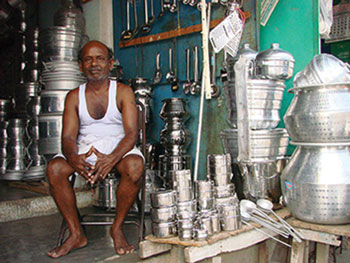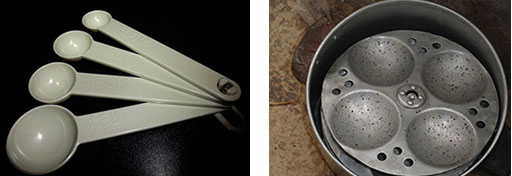2 Many ways to get to an answer
Working with combined shapes and solids is a good application of using analytical and logical thinking – which is a very mathematical activity in its own right. Composing and decomposing combined solids and shapes is also great for valuing students’ contributions and thinking, because there are normally many ways to get to an answer! This means that:
- the students can be creative in their thinking
- there are choices to be made
- the students will experience a sense of being able to be in control of their own thinking and learning.
Activity 2 asks your students to bring their own examples from home and think about different ways to work on the mathematics involved. It requires students to exchange their ideas with other students. They could be working in pairs or small groups.
Activity 2: Composing and decomposing familiar combined shapes and solids

Ask each student to bring any one utensil to class (for example, a spoon, glass, bowl (katori), container (of any shape), bottle, serving spoon (karchi), wok, pan, etc.). It is a good idea to bring in a few examples yourself so that you have enough utensils for everyone.
Part 1: The mathematical activity
Tell your students the following:
- Imagine you have to recreate the utensil you have brought using some commonly known shapes and solids. In how many ways could you do this? For example, one way to make a hollow rectangle like the one in Figure 3 would be to make the shape of the larger rectangle and then cut out the smaller rectangle, leaving the hollow rectangle.
Figure 3 A hollow rectangle.
- As in the example above, describe how you could recreate the utensils shown in Figures 4 and 5 using some commonly known shapes and solids.
Figure 4 A set of spoons. Figure 5 An idli maker.
- Work out the surface area of the object you brought to the class in at least two different ways. You should get the same surface area in all cases.
- Do the same for the volume of the object. You should get the same volume in all cases.
Part 2: Reflecting on your learning
Tell your students that this part of the activity asks them to think about their learning so that they can become better at, and feel better about, learning mathematics.
- What did you find easy or difficult about Part 1 of this activity?
- What did you like about this activity?
- What mathematics did you learn from this activity?
- What did you learn about how you (could) learn mathematics?
You may also want to have a look at the key resource ‘Using local resources’.
Case Study 2: Mrs Chadha reflects on using Activity 2
This activity made me realise how much more students engage with their learning when they use something that they bring to school. It seems it gives them automatic ownership of their learning! There was excitement when the students entered the classroom, showing the objects they had brought with them and wanting to know what exactly they were expected to do with them.
When the activity was given, they were grouped in fours so that they could have a variety of objects to investigate. I told them they were to pool their objects, but that I first wanted them to think about the questions individually. They were asked to each keep notes to talk about their thinking later in the group discussion. I insisted on this individual work because I wanted them to become aware of their own mathematical thinking power, and develop and value their own ideas. I wanted them to feel in control of their own thinking. If they were stuck with thinking about one object, they could select another one.
After about ten minutes I asked them to talk to each other about their answers. I told them that at this point they did not actually have to find the areas or volumes – they just had to talk about what shapes they could identify, or decompose their object into, in order to find the area or volume. I did not want them caught up in calculations and getting stressed about not remembering formulae. I wanted them to think about the thinking process involved in working with combined solids.
The discussion over the idli maker became rather intense, because some decided that they were hemispheres and there were a few who said that they were not exactly half-spheres – they felt they were parts of spheres. I noticed that some of the students were bridging the gap between their concrete understanding about shapes, solids, volumes and area by explaining their thinking while feeling and touching the utensils.
I was especially glad to hear the way that the students listened to each other. For some of the objects, the task was more difficult. One student who is otherwise quite quiet and reticent in class offered up a helpful idea in her group about two semi-circles actually making up a whole sphere, and I could see her pleasure when the other students praised her contribution – perhaps this will help her build her belief that she can do mathematics.
Pause for thought
|
1 Issues with learning mathematics


